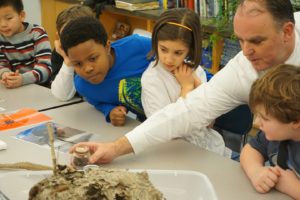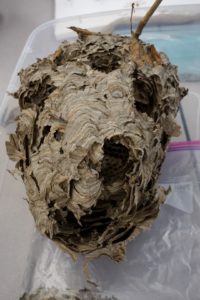 Excitement was “buzzing” as bug master Paul McMahon , exterminator by trade, entomologist by interest, and father by love of kindergartner Burke, gently pulled out his magic box filled with amazing creatures (dead of course) inside small baby food jars. One jar filled with black widow spiders might have caused our four and five year olds to cringe and back away. Not our kindergartners! Their eyes were transfixed as Paul showed them jarred specimens, snake skins, hornet nests, and colorful photos.
Excitement was “buzzing” as bug master Paul McMahon , exterminator by trade, entomologist by interest, and father by love of kindergartner Burke, gently pulled out his magic box filled with amazing creatures (dead of course) inside small baby food jars. One jar filled with black widow spiders might have caused our four and five year olds to cringe and back away. Not our kindergartners! Their eyes were transfixed as Paul showed them jarred specimens, snake skins, hornet nests, and colorful photos.
He shared stories and facts about common insects that secretly grace our lands and even homes in South Jersey. Even though he is an exterminator it was clearly evident that his love for learning about the natural world flows through him like a roaring river. The kids’ hands were flying up with questions with related (and even unrelated) stories of creatures that they have seen or owned. It was touching. Most importantly Paul’s message was clear throughout all his sessions with grades kindergarten through fifth grade. We humans and all these crawling, flying, slithering, and mysterious creatures are all a part of the Circle of Life. Each creature has its own place and purpose on this planet!!! Here is some of what the children learned from Paul’s generous visit to Friends School.
- Estimate of number of insects on the planet – 10 quintillion (That’s 10 followed by 18 zeroes) There are probably 10 million insect species that we might not even know about!
- Benefits of insects: pollinators – honey bees make it possible for us to have most of the yum
 my and healthy fruits and veggies we eat. Praying mantis and lady bus protect farm crops. Insects are also used in biomedical engineering. Grasshoppers (same neurological system that we have) and fruit flies (genetics) are the most tested.
my and healthy fruits and veggies we eat. Praying mantis and lady bus protect farm crops. Insects are also used in biomedical engineering. Grasshoppers (same neurological system that we have) and fruit flies (genetics) are the most tested. - Many insects are social insects – city planners study and use insect movements (for they are very efficient) to help them plan human roadways and human pathways.
- Two of the oldest insects he showed were the subterranean termites and the German cockroach. They date back to 250 million years! The termites live underground to maintain a certain body temperature and are important in breaking down branches and dead trees – a natural composter. The German cockroach is the most prolific and dominant. It is a pest and difficult to get rid of. It hides upside down. It is smaller and can hide in little cracks and crevices. The females also carry their egg sac underneath their hard shell next to their abdomen until it is time for the birth. Tough to kill for these reasons.

- Bed bugs – lay up to 300 to 500 eggs a month and can live up to one year!
- Fastest bug – If it was the size of a human, the American cockroach would run 200 mph.
- Black Widow Spiders – Yes, sometimes the female will bite off the head of the male. But listen to this gals – The male mostly crawls to the bottom of the web. He plucks the web thread (kind of like a harp) and knocks the female’s food down and eats it. Lazy bum!
- Pill Bug (commonly known as the Rolly Polly) – They are related to the lobster (a crustacean). A lobster gets its oxygen from the water through the gills. The pill bug gets its oxygen through the water in the ground and amongst the damp leaves. How cool is that!
- Lastly, some of us are startled when we go into our basements and these big crickets are jumping around. They are called Camel Crickets and they can be cannibalistic! Whew!
There it is. Bugs Bugs Bugs and more bugs! Thank you, Paul, for sharing your enthusiasm for the natural world. We loved it!
This blog post is part of an ongoing series by Teacher Peter Manzelmann on education and the natural world.



Follow and Contact Us